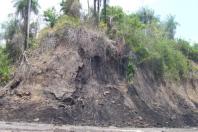Could Estonia's oil shale bolster Europe's energy security?
The tiny Baltic nation has unique experience with oil shale, a sedimentary rock that provides all of Estonia's electricity – and keeps it from depending on Russia for power.
By Isabelle de Pommereau, Correspondent June 21, 2014CSM
Ojamaa, Estonia — The SUV ride down the steep incline in Estonia's newest oil shale mine, the first to be built since the Soviet era, is bumpy.
At 105 feet below ground, Larissa Puhilas gets out. She inspects the soft brown rock that's just collapsed, after miners drilled and blasted a limestone wall to release the brown sedimentary oil shale. Big conveyer belts will bring it outside to be crushed and burned to produce power or further processed into oil.
An oil shale enrichment specialist, Ms. Puhilas is a player in one of Estonia's most important – and controversial – industries. Unlike shale oil, the liquid obtained by hydraulic fracturing (fracking) miles underground, Estonia's oil shale is a sedimentary rock containing kerogen found close to the surface. Estonia is the only country in the world whose energy sector depends on oil shale. In fact, practically all its electricity comes from the rock.
And with European countries seeking to reduce their dependence on imports of Russian gas, Estonia's energy self-sufficiency is suddenly drawing attention.
“Thanks to you, Estonia is currently one of the least dependent countries on the import of energy in the European Union,” Estonian President Toomas Hendrik Ilves told miners last year when the mine opened some 40 miles from Narva, on the Russian border. “This in turn is an Estonian security and independence matter.”
A unique industry
Since discovering that shale could power its locomotives in the early 1920s, the tiny Baltic state has become a world master in mining and processing the fossil fuel.
“We are one of the few countries producing our own electricity and even exporting it – in today's world, it is important,” says Peeter Eek of Estonia's environmental ministry, alluding to Russia's political use of its gas resources. “We have to balance our social, economic, and environmental interest.”
Over the past century, the oil shale industry has given Estonia a unique profile. It fed Germany's World War II apparatus, and heated Leningrad and Tallinn in Soviet times, when the construction of two huge oil-shale power plants in Narva – still the world's largest – spurred massive immigration from other Soviet republics.
“During Soviet occupation, oil shale became the technology of Estonia, a way to manifest Estonian-ness," says economist Rurik Holmberg of the Swedish Energy Agency.
The industry suffered when the Soviet market collapsed in the 1990s. But with 18 million tons of the rock mined this year (compared with 30 million tons in the industry's heyday in 1981), Estonia's energy industry, concentrated in its Russian-speaking northeast, generates enough power for the country's 1.3 million inhabitants. It exports more and more of it to Finland, Latvia, and Lithuania, too.
“Here it's easy to mine, and that's the reason we succeeded,” says Andres Mäe, an Estonian energy analyst.
An environmental cost
But while oil shale "gives Estonia a certain energy independence," Mr. Mäe adds that "it's very dirty." The processing of oil shale creates tons of carbon dioxide and huge amounts of waste that ends up in "ash hills" in the countryside.
“The big question is: How much shale mining do we allow?“ says Mr. Eek of the environmental ministry. “We are looking at how to reduce the impact on the environment at each stage, from mining to processing.”
Estonia's accession to the EU forced it to deal with the industry's environmental impact. That led to “impressive” steps to diversify its energy mix, limit shale mining, and invest in technology, says Thea Khitarishvili of the International Energy Association Agency in Paris. For example, she says, a new refinery built by state-owned Eesti Energia can use the gas released in processing oil shale to also produce electricity.
But that's not enough, says Valdur Lahtvee of the Stockholm Environment Institute in Tallinn. It "makes using the oil shale more efficient, but oil shale remains the carbon-richest fuel in Europe.” He calls for dropping oil shale, arguing that Estonian can get all its energy from bio mass and wind.
The limits of oil shale
Estonia hopes to export its pioneering oil shale technology abroad. One hurdle is that although the tiny country knows its own oil shale well, the nature of oil shale reserves elsewhere – Jordan, the US, Australia, and others have substantial deposits – has been little studied. Many countries' oil shale is much harder to access than Estonia's.
And while oil shale is relatively attractive now – it is currently cheaper than alternatives like oil, natural gas, and renewable energy sources – that could change, particularly if the European Union adjusts its climate change policy.
Under the EU's “cap and trade” policy, polluting companies in the EU need to buy carbon credits, effectively making dirty fuels like oil shale more expensive. Lately, prices for those permits have been dropping, lowering the incentive for companies to use cleaner energy and making oil shale more cost effective.
“CO2 quotas are not strict anymore,” says Mäe, the energy analyst. “But that could change once the recession is over."
Mr. Lahtvee predicts that the EU is soon going to raise carbon credit costs, which would make it too expensive for oil shale companies to continue spewing high levels of dirty gases. ”Soon oil shale will lose its competitive edge,” he says.
The best option, most experts agree, is to make the industry cleaner, not to drop it – and not just for energy security reasons. The industry is also the lifeblood of a predominantly Russian region near the Russian border, where blue collar jobs are hard to find.
“Keeping oil shale [grants] not only self sufficiency in energy, but also avoids any potential social problem in Estonia's northeast,” says Rurik Holmberg, a former OECD observer in Narva. To end the oil shale industry would be to end many jobs for Narva's community. That could stir social unrest and, potentially, Russia's interest in intervening in the region. “Estonia needs the oil shale-based energy sector for its overall security.”
“We are one of the most energy independent countries in the European Union, and we will not compromise our energy security," Juhan Parts, who was economic minister until April, said recently. “We have a large neighbor.”
http://www.csmonitor.com/World/Europe/2014/0621/Could-Estonia-s-oil-shal...


